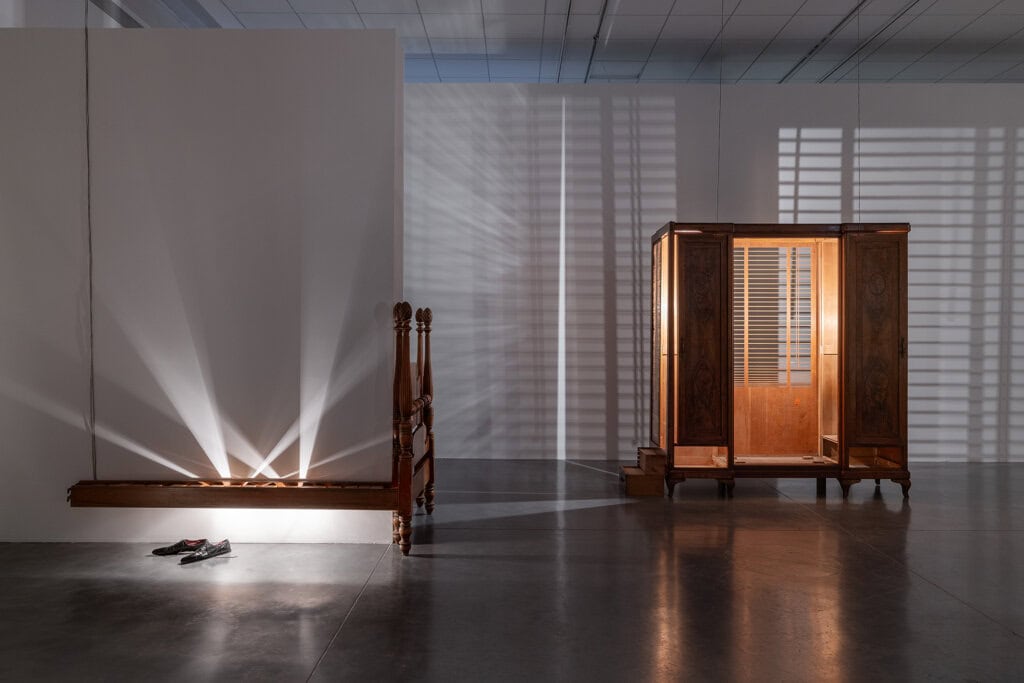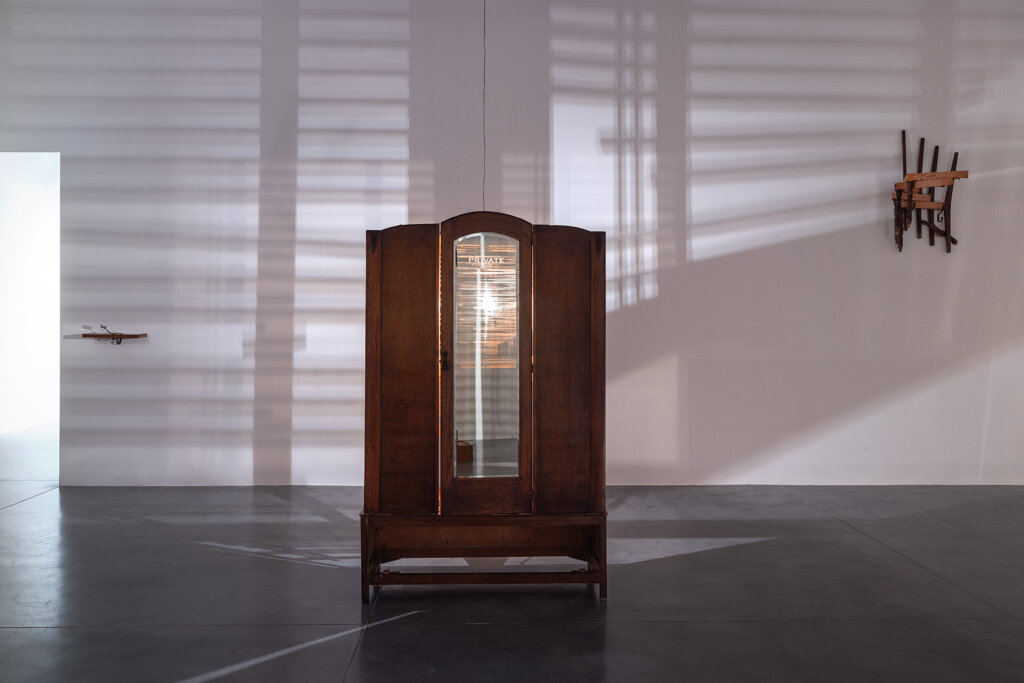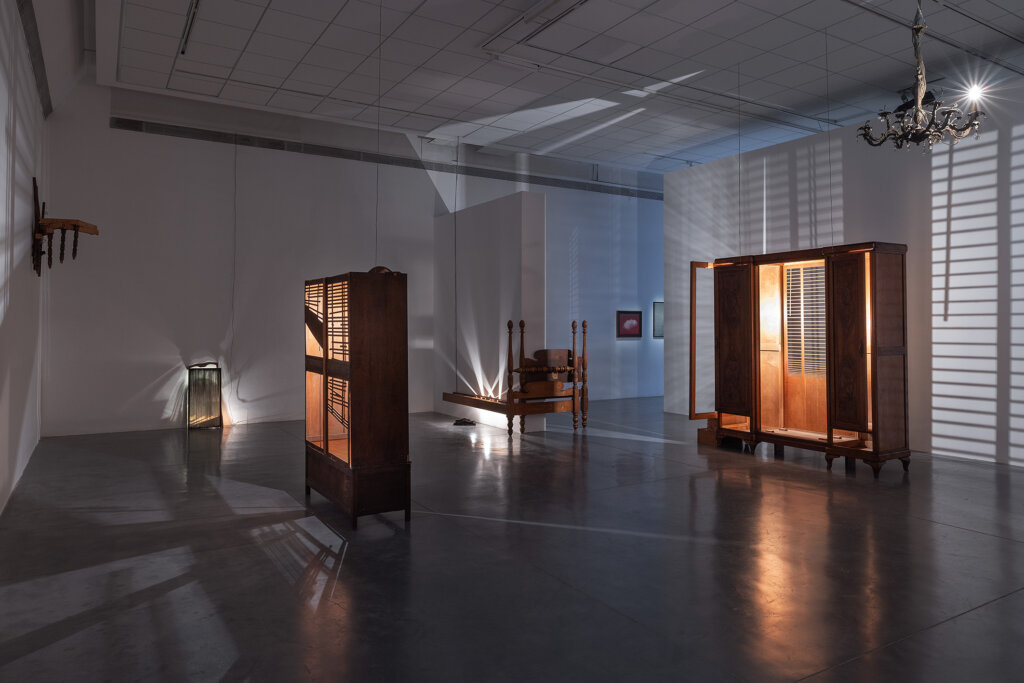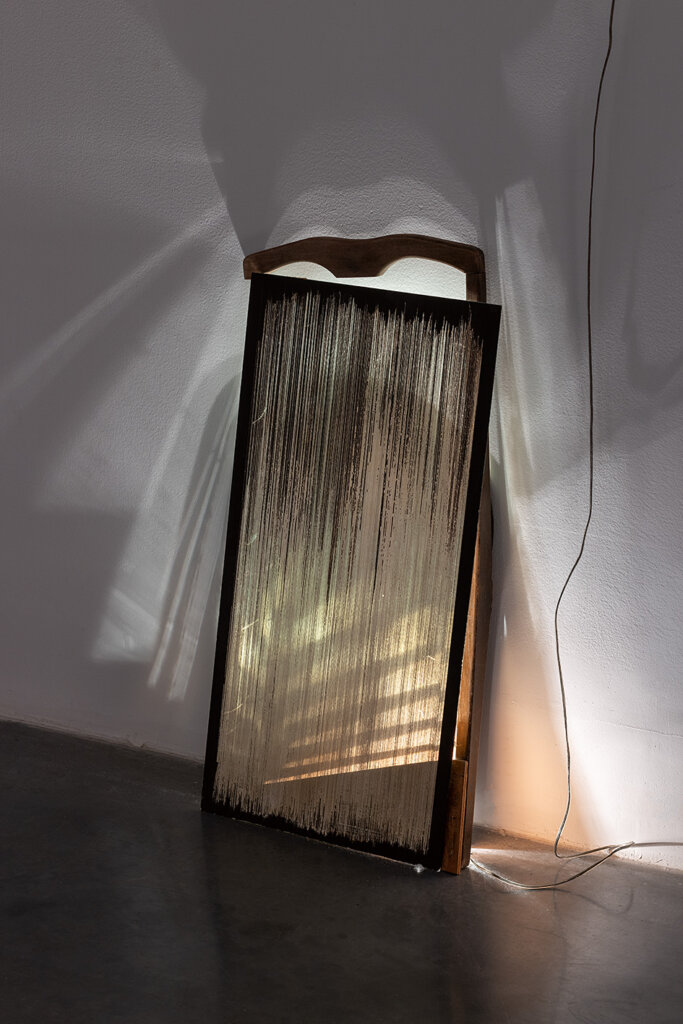Ron Asulin: Amerika
Curator: Irena Gordon
24/07/2025 -
22/11/2025

Ron Asulin . b. 1990
Amerika, 2025
Not belonging to any place, any time, any love. A lost origin, the impossibility to take root, a rummaging memory, the present in abeyance. The space of the foreigner is a moving train, a plane in flight, the very transition that precludes stopping. As to landmarks, there are none. His time? The time of resurrection that remembers death and what happened before, but misses the glory of being beyond: merely the feeling of a reprieve, of having gotten away.
(Julia Kristeva, Strangers to Ourselves, trans. Leon S. Roudiez, New York: Columbia UP, 1991, pp. 7—8)
Alternating currents of suspicion and desire define Ron Asulin’s sculpture, which seeks meaning through dissection and deconstruction, motion and duplication. Asulin extracts the story embedded in matter and form by means of a meticulous sculptural practice akin to the methodical probing of a detective intent on uncovering the manner in which things are constructed. He manipulates things and materials, exploring how they may spawn otherness: as object, as place, as space.
Amerika, spelled in the German manner, is a house that transforms into a space of passages and burrows, a dramatic interplay of light and shadow, a labyrinth of optical illusions and peepholes. It is a breached, deceptive domestic realm, accessible through a cabinet. Its mirrored door, cut in two and mounted on either side, creates the illusion of an endless corridor. A beam of light erupting from one of the cabinet doors leads to a fan-shaped structure of interlocking chairs, echoing a fragmentary staircase. Several pairs of shoes are arranged into what appears to be a dandified torso atop the cabinet’s drawer. Another pair, seemingly wedged at the extreme angle of view, rests beneath a narrow, scaled down single bed. The gaze shifts, drawn from one sculpture to the next, while the entire scene is ostensibly controlled by a hidden puppeteer inthe form of an old chandelier suspended from a rickety ceiling. This is the invisible apparatus that gives rise to a lighting system.
The structural-architectural progression of the exhibition, which evolved from Asulin’s MFA graduation project at UCLA, draws inspiration from film noir—a genre of crime cinema originating in the 1940s and 1950s, often centered on a cynical detective navigating a world steeped in fear, alienation, loneliness, and dread, counterbalanced by an enigmatic femme fatale, a seductive agent of destruction. The detective protagonist of these films becomes a stranger in his own home, pushed to the social margins. He condemns himself to a perpetual drift—forever fleeing and hiding from the encroaching forces of Los Angeles’ lustful, capitalist society. The detective pursues the mystery’s solution while succumbing to temptation, challenge, and aggression. In doing so, he propels both the plot and his own being, all the while risking being swallowed up by the very corrupt system he resists and becoming complicit in its crimes. These films are marked by nocturnal settings, shadow-drenched lighting, and dramatic angles inspired by German Expressionism—an aesthetic brought to Hollywood by Jewish filmmakers who fled Nazi Germany.
One of film noir’s most iconic directors, Fritz Lang and the story of his escape to America and alleged meeting with Nazi Propaganda Minister Joseph Goebbels, lie at the core of Asulin’s inquiry. Alongside the sculptural suite, Asulin created a series of expressive drawings illustrating Lang’s potentially fictive account of the events: maintaining that on the very day he had planned to flee to Paris by train, Goebbels
had offered him control of the German film industry. The meeting ran long, the banks closed, and Lang was forced to flee Germany without this money. The drawings are presented as a storyboard on a handout map, available at the installation’s entrance.
In Amerika, Asulin draws the viewer to the depths of the house, to the cabinet’s innards, to the contour of a chair, to the corner of a bedframe’s base. The mechanisms of uprooting and flight, identified in the story of Lang’s escape and the films he directed while in exile are triggered by charging domestic objects
with a magical power imbued with secrecy and yearning. Structural manipulations drive the plot, which unfolds as a virtuoso formal choreography of horror and anxiety, destabilizing the familiar and known, subverting the graspable. The potential for transformation and passage from one structure to another is extracted
from the position of the outsider. Space is not perceived as a given state but as a dynamic and disorienting labyrinth, and exile is not just a tragic consciousness, but a physics of objects, a transformation of familiar structures, the maneuvering of material that carves lines of flight. This apparatus yields parallel and intersecting narratives, one of which belongs to writer and translator Oded Wolkstein, who reads his story, his voice coming from the remnant of a telephone receiver.
The installation as a whole consists of passages, intermediate spaces, and interstices, embodying the existence of a liminality in a non-place. The works mark the foreignness of both the object and the sculptural space, their being outside the existing order, while undermining the viewer’s ability to maintain an objective, distant position. The house remains as a kinetic husk, a film set abandoned by its stars, yet continues to produce light, shadow, and illusion. Paradoxically, in the process, it calls for engagement, critique, and confrontation of a traumatic reality.
The exhibition is supported by:
The Israel Lottery Council for Culture & Arts, ArtNow, Yehoshua Rabinovich Tel Aviv, Foundation for the Arts, and the Alan D. Leve Center for Jewish Studies, UCLA
The exhibition is dedicated with love and longing to Michal Barnoach of blessed memory
Special thanks to:
Meital Aviram for the dialogue we shared



Installations photos: Elad Sarig

